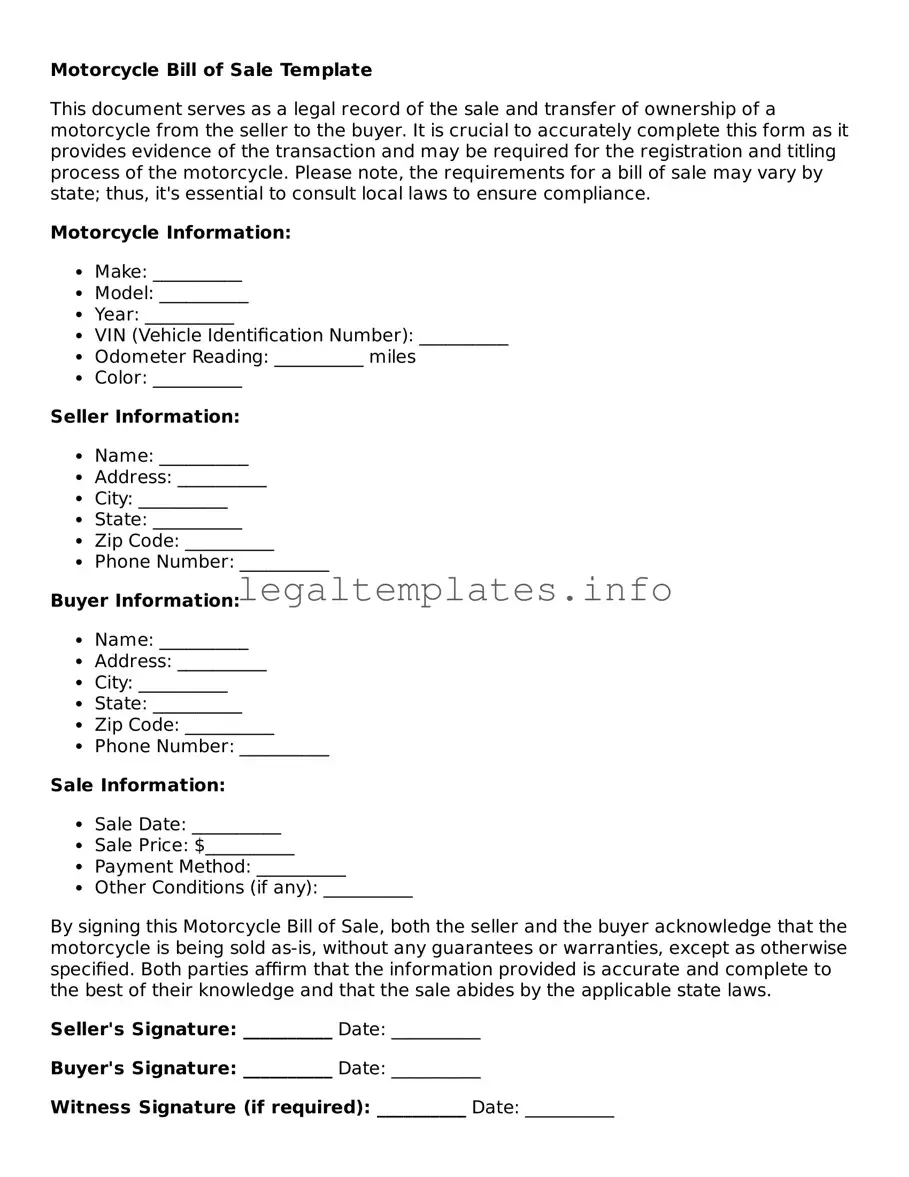The Motorcycle Bill of Sale form shares similarities with the Vehicle Bill of Sale form. Much like its motorcycle-specific counterpart, the Vehicle Bill of Sale serves as a legal document that records the sale and transfer of ownership of a vehicle, which can include cars, trucks, and vans, among others. It typically includes essential information such as the make, model, year, VIN (Vehicle Identification Number), the sale price, and the details of the buyer and seller. This document is crucial for the buyer’s registration and titling of the vehicle and for the seller's release of liability.
Another document resembling the Motorcycle Bill of Sale is the Boat Bill of Sale. This document functions similarly by detailing the transaction and change of ownership of a boat. It records specific information relevant to the sale, including the make, model, year, HIN (Hull Identification Number), and oftentimes the boat’s trailer and motor details if they are included in the sale. Both documents serve as vital proof of purchase and are instrumental in the registration and titling process of the respective vehicles.
Similarly, the Aircraft Bill of Sale parallels the Motorcycle Bill of Sale. An Aircraft Bill of Sale documents the sale and ownership transfer of an airplane, including critical details like the make, model, serial number, and the particulars of the buyer and seller. Despite the significant difference in the type of vehicle, both documents play an essential role in establishing legal ownership and are required for the registration process with the relevant authority, such as the Federal Aviation Administration (FAA) for aircraft.
The General Bill of Sale is akin to the Motorcycle Bill of Sale but with a broader application. This document is used to transfer ownership of personal property other than vehicles, such as electronics, animals, or furniture. Although more generic, it serves the same primary purpose: to provide a written record of the transaction that includes a description of the item, sale price, and the parties involved. This document can offer legal protection and serve as proof of ownership in a similar manner.
Comparable in purpose is the Business Bill of Sale, which is used when an entire business or a portion of its assets are sold. Like the Motorcycle Bill of Sale, it records the details of the transaction including the business assets being transferred, the sale price, and the information of the buyer and seller. This document is crucial for both parties as it legitimizes the transaction and can be used for tax and licensing purposes, similar to how a Motorcycle Bill of Sale is used for registration and titling.
The Equipment Bill of Sale also shares common ground with the Motorcycle Bill of Sale. It is specifically designed for the sale and purchase of equipment, such as heavy machinery or office equipment. The document includes a description of the equipment being sold, the sale price, and the details of the buyer and the seller, paralleling the structure of a Motorcycle Bill of Sale. Both serve as a receipt for the transaction and are important for the subsequent registration or use of the items involved.
Lastly, the Firearm Bill of Sale closely resembles the Motorcycle Bill of Sale in its role as a transactional record. This document outlines the sale of a firearm, detailing the make, model, caliber, serial number, and the identities of the buyer and seller, much like the motorcycle document outlines specifics of the bike. In many jurisdictions, this form is crucial for the legal transfer of ownership and may be required for the buyer’s registration or licensing of the firearm, underscoring its similarity in function and importance.
